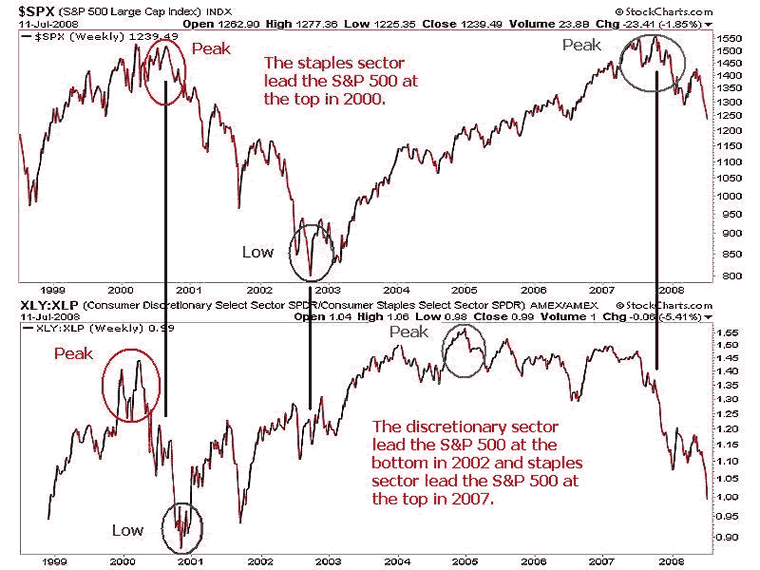Consumer Discretionary Spending Sector Leads Stock Market Tops and Bottoms
Stock-Markets / Sector Analysis Jul 15, 2008 - 03:10 AM GMTBy: Donald_W_Dony

 The spending habits of the largest single element of the economy can provide important information as to the major peaks and troughs of the stock market. The consumer, which equals about 2/3rds of the economy, plays a vital role in the business cycle. The normal contraction and expansion of the economy often requires the consumer to shift their spending to reflect the current state of the economy. This shifting of spending habits between discretionary and staples provides valuable clues to the major peaks and lows of the stock market.
The spending habits of the largest single element of the economy can provide important information as to the major peaks and troughs of the stock market. The consumer, which equals about 2/3rds of the economy, plays a vital role in the business cycle. The normal contraction and expansion of the economy often requires the consumer to shift their spending to reflect the current state of the economy. This shifting of spending habits between discretionary and staples provides valuable clues to the major peaks and lows of the stock market.
In more favourable economic times, the consumer usually begins purchasing those items that they would like but do you necessarily require. These items are classified as discretionary. During economic periods of contraction, consumers often fore go their discretionary purchases and focus on those items that they need but do not necessarily want. These items are classified as staples.

This movement of buying between discretionary and staples purchases can be tracked and used as a leading indicator on the stock market. In Chart 1, the Consumer Discretionary Sector ETF (XLY) is divided by the Consumer Staples Sector ETF (XLP). In the lower portion of the chart, when the line is rising, this means that the discretionary sector has greater relative performance then the staples sector. The opposite is also true. When the line declines, staples are now outperforming the discretionary sector.
In 2000, the line in the lower portion of Chart 1, peaked and began to fall. This means that consumer spending had started to shift to the staples sector. The S&P 500 crested six months later. In late 2000, consumer spending again moved back to the discretionary sector as indicated by the rising line. The stock market bottomed 19 months later in 2002. Discretionary spending by consumers continued to outperform the staples sector until early 2005. As the line in the lower portion of Chart 1 began to drift lower in 2005, this action suggested that consumer funds were shifting out of discretionary products and flowing into the safer staples sector once more. By late 2007, consumer spending toward discretionary items remained weak and consumer capital had steadily moved toward the staples. By October 2007, the stock market had peaked.
The relationship between consumer spending on discretionary and staples sectors often has a lead time of 1 to 2 years over the stock market. At present, there is no evidence of capital shifting back towards the discretionary sector. This would suggest that the current bear market in the S&P 500 has another 1-2 years before reaching a bottom.
Additional research can be found in the July newsletter. Go to www.technicalspeculator.com and click on member login.
Your comments are always welcomed.
By Donald W. Dony, FCSI, MFTA
www.technicalspeculator.com
COPYRIGHT © 2008 Donald W. Dony
Donald W. Dony, FCSI, MFTA has been in the investment profession for over 20 years, first as a stock broker in the mid 1980's and then as the principal of D. W. Dony and Associates Inc., a financial consulting firm to present. He is the editor and publisher of the Technical Speculator, a monthly international investment newsletter, which specializes in major world equity markets, currencies, bonds and interest rates as well as the precious metals markets.
Donald is also an instructor for the Canadian Securities Institute (CSI). He is often called upon to design technical analysis training programs and to provide teaching to industry professionals on technical analysis at many of Canada's leading brokerage firms. He is a respected specialist in the area of intermarket and cycle analysis and a frequent speaker at investment conferences.
Mr. Dony is a member of the Canadian Society of Technical Analysts (CSTA) and the International Federation of Technical Analysts (IFTA).
Donald W. Dony Archive |
© 2005-2022 http://www.MarketOracle.co.uk - The Market Oracle is a FREE Daily Financial Markets Analysis & Forecasting online publication.


